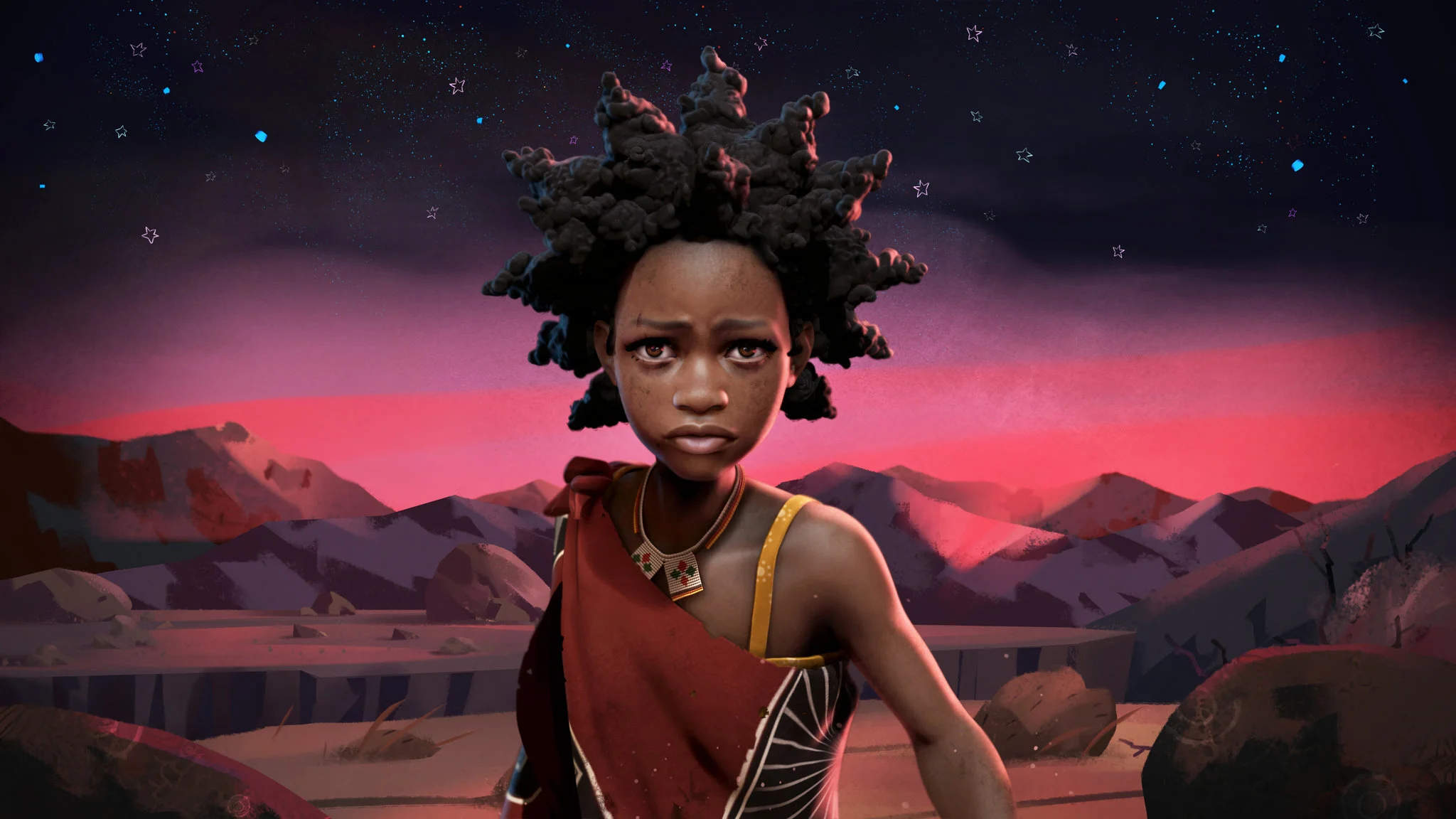Pixar’s Toy Story (1995-2019) series explores a landscape full of plastic. Most of the main characters are plastic. Sheriff Woody isn’t made out of wood at all; his head, hands, and boots are all plastic. Mr. and Mrs. Potato Head, and their many anatomical add-ons, are plastic. T-Rex is plastic. The little soldiers are plastic, as are their parachutes. Mr. Spell’s outer shell is plastic. And Buzz Lightyear, when he first arrives in Toy Story (John Lasseter, 1995), is the shiniest, newest, most gorgeous piece of plastic anyone has ever seen.
Read MoreKipo and the Age of Wonderbeasts (Radford Sechrist, 2020-) is a colourful, post-apocalyptic animated adventure series based on the webcomic Kipo, which debuted on Netflix in early 2020 to much critical acclaim (Fig. 1). The story follows the titular Kipo, a 13-year-old “burrow girl” who finds herself thrust from the safety of her underground home to a surface world filled with talking, anthropomorphized animals, or “mutes,” as well as titanic, kaiju-sized “mega mutes.”
Read MoreAt Annecy 2020, Women in Animation held a digital summit on the theme ‘Reimagining the Future: Race, Solidarity and the Culture of Work’. At the panel ‘Black Women in Animation: Looking to the Future’, moderator Jamal Joseph from Columbia University asked, ‘What needs to happen now? How do we get more women in animation and how do we get more women of colour in animation and film?’
Read MoreWhat’s in a flerken? Having watched Goose regurgitate the tesseract at the post-credit close of Captain Marvel (Anna Boden & Ryan Fleck, 2019), I immediately wanted to know: what’s in a flerken? Finding my answer meant looking to the comics, in particular the reboots of Captain Marvel in print by both Kelly Sue DeConnick and Margaret Stohl. I have to admit to not learning much more about flerkens, alien creatures which appear to resemble ginger cats, but DeConnick and Stohl’s revisionings did give me a lot more insight into Carol Danvers/Captain Marvel as a contemporary woman who struggles with her history.
Read MoreThe most recent Pixar film, Onward (Dan Scanlon, 2020), tells the story of two brothers, Ian and Barley, who set out on a magical quest in a bid to spend one final day with their late father. On Ian’s sixteenth birthday he is presented with a gift left to him by his father, whom he has never met, with the instructions that he and his older brother could only open it when they were both at least sixteen. Onward is therefore a story strongly embedded in loss. Ian is a teenager, unsure of himself and anxious about transitioning into adulthood.
Read MoreIn a world of globalised animation, anime’s influence is ever expanding, ranging from adult Netflix animations like Castlevania (Warren Ellis, 2017-) to a wide variety of western children’s TV shows from Teen Titans (Glen Murakami and Sam Register, 2003-2006) to She-Ra and the Princesses of Power (Noelle Stevenson, 2018-2020).
Read MoreMakoto Shinkai’s animated film Kimi No Na Wa, translated as Your Name, was a critical and commercial hit when it was released in 2016. The film depicts the strange and wondrous journey of two high school teenagers, city boy Taki in Tokyo and countryside girl Mitsuha in rural lakeside Itomori, who are inexplicably swapping bodies with each other.
Read MoreReformation-era German engraver, painter and printmaker Hans Holbein and quirky contemporary Polish animator Kajetan Obarski are two artists separated by several centuries that, in their similarities, attest to historical parallels and ramifications of the fantastic. As this post identifies, both artists illustrate the grotesque through a Carnivalesque trope in their work of the Danse Macabre. Both also prophetically remind their viewers of the stark facts of mortality, of people who are “like grass, and all their glory is like the flowers of the field; the grass withers and the flowers fall” (Peter 1:24-25).
Read MoreTo make the iconic French Provençal dish ratatouille, one must first prepare the ingredients, peel and cut the onions, chop the garlic, thinly slice the courgettes and the aubergines, de-seed the peppers and chop the tomatoes. To make animated ratatouille, one must simply pick up a pen.
Read MoreThe resources below were originally compiled in response to an email my colleague Kodi Maier sent to the Society for Animation Studies listserv in order to begin a conversation and resource exchange aimed at defining best practices for creating an anti-racist classroom in our subfield. I would like to once again thank Kodi for taking the initiative to remind us of our collective responsibility as scholars, educators, and human beings.
Read MoreThe Covid19 pandemic is not just about a virus; it is a social, economic and cultural phenomenon. The impact that it is making across the globe is severe, and the role of (perhaps even the need for) fantasy during this changing and hyperdigitalized world is more necessary than ever given the important questions being raised about the nature of our cultural consumption.
Read MoreTo celebrate the Fantasy/Animation website’s 100th (yes, 100th!) blog post we give you our Top 100 Fantasy/Animation films. A huge thank you to those academics, practitioners, VFX artists, animators, curators, filmmakers and fans out there who have contributed to Fantasy/Animation since we began. Here’s to the next hundred!
Read MoreThe fantasy genre has deep connections with medieval and pre-medieval iconography. J.R. Tolkien, an Oxford professor of Anglo-Saxon literature and English literature and language, is often credited as being the father of modern fantasy (also called “high fantasy”). His novels, The Hobbit (1954) and The Lord of the Rings (1954- 1955), set the stage for later mid-century fantasy works such as Peter S. Beagle’s The Last Unicorn (1968). Both Tolkien and Beagle included elements found in pre-medieval and medieval iconography, from the dragon Smaug in The Hobbit to the creatures in Mommy Fortuna’s Midnight Carnival from The Last Unicorn, which included a satyr, a manticore, a Midgard serpent and a harpy.
Read MoreFor nearly 100 years, the name Walt Disney has been synonymous with top class, polished, and popular animation. Teams of animators churn out major films every couple of years, often to great financial success, and usually with a very particular ‘Disney-esque’ style. Timothy White purports that this style is, at least partly, typified by an attempted realism and continuity editing, typically associated with “Hollywood” cinema (1992: 3-16), meanwhile Paul Wells similarly ascribes a “mimetic” quality to Disney’s style, describing it as “orthodox” (2003: 220).
Read MoreCommenting on the fan/ critic division of Star Wars Episode IV: A New Hope (George Lucas, 1977), Todd Berliner (2017) observes that: The original Star Wars (1977) has become one of the most widely and intensely loved movies of all time. Film scholars, however, lambasted Star Wars for its simplicity. Peter Lev calls it one of the “simple, optimistic genre films in the late 1970s.” David Cook says it privileges “a juvenile mythos.” Jonathan Rosenbaum calls the movie mostly “fireworks and pinball machines,” a deliberately silly film that offers only “narcissistic pleasures.”
Read MoreIn today’s visual culture, animation is at an interesting turning point, poised between fiction and fact, perhaps combining the two. We are increasingly confronted with ubiquitous animated images, videos, and gifs, for example, on smartphones, computers, in airplanes, doctors’ offices, schools, and many more, which are all used uncritically to represent or express real events, feelings, processes, and interactions.
Read MoreThere is no accounting for taste at the best of times, but this past month’s constant stream of dire global pandemic news and projections has wreaked havoc on streaming algorithms, as quarantined audiences scramble to keep themselves occupied with a wide variety of new content. While many have opted to dive headfirst into big cat-themed true crime, others are eschewing escapist entertainment in favor of a morbid fascination with newly relevant fictional contagion narratives.
Read MoreMichael Dougherty’s Godzilla: King of the Monsters (2019) was the thirty-fifth feature to star the giant kaiju (the Japanese word generally used to refer to giant movie monsters). Although it was the latest in a series of films spanning 65 years, it was only the fourth time that “the Big G” had appeared as a fully digitally animated creature, discounting the anime series on Netflix (2017/8).
Read MoreFrom the multi-sunned vistas of Star Wars VIII: The Rise of Skywalker (J.J. Abrams, 2019) to the Slavic monster-hunting in Netflix’s The Witcher (Lauren Schmidt Hissrich, 2020) there has been an immense rise in fantasy and science fiction fuelled by spectacularly crafted movie magic.
Read MoreTwo recent big screen biopics released within a few months of each other between October 2018 and May 2019 offered notably contrasting portrayals of popular musical icons. But if the lukewarm critical reception surrounding recent Freddie Mercury/Queen biopic Bohemian Rhapsody (Bryan Singer, 2018) put the genre under scrutiny for its questionable re-appropriation of real-life, then Rocketman (Dexter Fletcher, 2019) seemed remarkably immune to such criticisms.
Read More



















